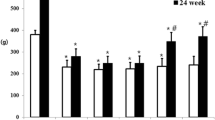Abstract
The effect of an analogue ofl-carnitine, propionyl-l-carnitine, on the electroretinogram, motor nerve conduction velocity and nerve blood flow was determined in rats with streptozotocin-induced diabetes, and was compared with the effects of insulin alone or combined therapy. Oral administration of propionyl-l-carnitine (3 g/kg daily for 4 weeks) significantly increased caudal nerve motor conduction velocity and sciatic nerve blood flow in diabetic rats. There were no differences in the effects of insulin (8–10 U daily for 4 weeks), propionyl-l-carnitine and combined therapy. Although propionyl-l-carnitine significantly shortened the peak latency of the electroretinogram b-wave in diabetic rats, its effect was far weaker than that of insulin or combined therapy, with combined therapy producing the greatest improvement. These effects of propionyl-l-carnitine were accompanied by a decrease of serum lipid levels, an increase of the sciatic nerve carnitine content, and no changes of the tissue (nerve and retinal) sorbitol andmyo-inositol concentrations. In contrast, insulin significantly reduced the tissue sorbitol content and markedly increasedmyo-inositol. These findings suggest that propionyl-l-carnitine may improve diabetic neuropathy and retinopathy without influencing the polyol pathway, and that this beneficial effect may be mediated through the amelioration of microcirculation and tissue carnitine content, thus probably increasing fatty acid oxidation.
Similar content being viewed by others
References
Kohner EM (1993) Diabetic retinopathy. Br. Med J 307: 1195–1199
Hotta N, Sakamoto N (1990) Aldose reductase inhibitors. In: Alberti KGMM, Krall LP (eds) The diabetes annual 5. Elsevier Science, Amsterdam, 330–361
Gorio A, Diguilo AM, Tenconi B, Donadoni L, Germani E, Bertelli A, Mantegazza P, Maccari P, Ramacci MT (1992) Peptide alterations in autonomic diabetic neuropathy prevented by acetyl-L-carnitine. Int J Clin Pharm Res 12:225–230
Ido Y, McHowat J, Chang KC, Arrigoni-Martelli E, Orfalian Z, Kilo C, Corr PB, Williamson JR (1994) Neural dysfunction and metabolic imbalances in diabetic rat. Prevention by acetyl-l-carnitine. Diabetes 43:1469–1477
Lowitt S, Malone JI, Salem AI, Kozak WM, Orfalian Z (1993) Acetyl-l-carnitine corrects electroretinographic deficits in experimental diabetes. Diabetes 42:1115–1118
Rodrigues B, Xiang H, McNeil JH (1988) Effect ofl-carnitine treatment on lipid metabolism and cardiac rats. Diabetes 37:1358–1364
Yonemura D, Aoki T, Tsuzuki K (1962) Electroretinogram in diabetic retinopathy. Arch Ophthalmol 68:49–54
Wachtmeister L, Dowling JE (1978) The oscillatory potentials of the mudpuppy retina. Invest Ophthalmol Vis Sci 29:1631–1635
SimonsenSE (1968) ERG in diabetics. In: Francois J (ed) The clinical value of electroretinography. Karger, Basel, pp 403–412
Miller RF, Dowling JE (1970) Intracellular responses of the Müller (glial) cells of mudpuppy retina: their relation to the b-wave of the electroretinogram. J Neurophysiol 33:323–341
Kozak WM, Deneault LG, Rogowska J (1983) ERG amplitude and latency changes during early diabetes mellitus in rats. Doc Ophthalmol Proc Ser 37:351
Pasini E, Comini L, Ferrari R, DeGiuli F, Menotti A, Dhalla NS (1992) Effect of propionyl-l-carnitine on experimentally induced cardiomyopathy in rats. Am J Cardiovasc Pathol 4:216–222
Hotta N, Kakuta H, Fukasawa H, Kimura M, Koh N, Iida M, Terashima H, Morimura T, Sakamoto N (1985) Effect of a fructose-rich diet and the aldose reductase inhibitor, ONO-2235, on the development of diabetic neuropathy in streptozotocin-treated rats. Diabetologia 28:176–180
Segawa M, Hirata Y, Fujimori S, Okada K (1988) The development of electroretinogram abnormalities and the possible role of polyol pathway activity in diabetic hyperglycemia and galactosemia. Metabolism 37:454–460
Miyoshi T, Goto I (1973) Serial in vivo determinations of nerve conduction velocity in rat tails: physiological and pathological changes. Electroencephalogr Clin Neurophysiol 35:125–131
Hotta N, Kakuta H, Fukasawa H, Koh N, Sakakibara F, Komori H, Sakamoto N (1992) Effect of niceritrol on streptozotocin-induced diabetic neuropathy in rats. Diabetes 41:587–591
Koshu K, Kamiyama K, Oka N, Endo S, Takaku A, Saito T (1982) Measurement of regional blood flow using hydrogen gas generated by electrolysis. Stroke 13:483–487
Clements RS, Morrison AD, Winegrad Al (1969) Polyol pathway in aorta: regulation by hormones. Science 166:1007–1008
MacGregor LC, Matschinsky FM (1985) Treatment with aldose reductase inhibitor or with myo-inositol arrests deterioration of the electroretinogram of diabetic rats. J Clin Invest 76:887–889
McGarry JD, Foster DW (1976) An improved and simplified radioisotopic assay for the determination of free and esterified carnitine. J Lipid Res 17:277–281
Bremer J (1983) Carnitine: metabolism and functions. Physiol Rev 63:1420–1480
Broderick TL, Quinney HA, Lopaschuk GD (1992) Carnitine stimulation of glucose oxidation in the fatty acid perfused isolated working rat heart. J Biol Chem 267:3758–3763
Lowitt S, Malone JI, Salem A, Korthals J (1990) Acetyl-l-carnitine improves neuronal function in streptozotocin (STZ) diabetic rats. Diabetes 39 [Suppl 1]:155A
Williamson JR, Chang K, Frangos M, Hasan KS, Ido Y, Kawamura T, Nyengaard JR, Van den Enden M, Kilo C, Tilton RG (1993) Hyperglycemic pseudohypoxia and diabetic complications. Diabetes 42:801–813
Cameron NE, Cotter MA (1994) The relationship of vascular changes to metabolic factors in diabetes mellitus and their role in the development of peripheral nerve complications. Diabetes Metab Rev 10:189–224
Garrelds IM, Elliot GR, Zijlstra FJ, Bonta IL (1994) Effects of short-and long-term feeding ofl-carnitine and congeners on the production of eicosanoids from rat peritoneal leucocytes. Br J Nutr 72:785–793
Bertelli A, Bertelli AA, Galmozzi G, Giovannini L, Mian M (1993) Thrombosis induced by endothelin (ET-1) and carageenin in rats treated with indomethacin and propionyl carnitine. Drugs Exp Clin Res 19:75–78
Van Hinsbergh VW, Scheffer MA (1991) Effect of propionyl-l-carnitine on human endothelial cells. Cardiovasc Drugs Ther 5 [Suppl 1]:95–105
Paulson DJ, Traxler J, Schmidt M, Nooan J, Shug AL (1986) Protection of the ischaemic myocardium byl-propionylcarnitine: effects on the revovery of cardiac output after ischemia and reperfusion, carnitine transport, and fatty acid oxidation. Cardiovasc Res 20:536–541
Arduini A, Gorbunov N, Arrigoni-Martelli E, Dottori S, Molajoni F, Russo F, Federici G (1993) Effect ofl-carnitine and its acetate and propionate esters on the molecular dynamics of human erythrocyte membrane. Biochim Biophys Acta 1146:229–235
Author information
Authors and Affiliations
Rights and permissions
About this article
Cite this article
Hotta, N., Koh, N., Sakakibara, F. et al. Effects of propionyl-l-carnitine and insulin on the electroretinogram, nerve conduction and nerve blood flow in rats with streptozotocin-induced diabetes. Pflugers Arch. 431, 564–570 (1996). https://doi.org/10.1007/BF02191904
Received:
Revised:
Accepted:
Issue Date:
DOI: https://doi.org/10.1007/BF02191904




